
Neil Foster describes his reacquaintance with old friend Steve Bancroft as they climbed their first route together - Zulu Demente at Riglos - over 35 years after the pair first met...
(with apologies to Cormac McCarthy)
Our introduction to the delights of Riglos hadn't gone according to plan. A freezing, cloudy November day deteriorated rapidly. Heavy, continuous rain swept in before the hotaches from our first route had fully subsided. It was only a single pitch 6a+ but it had felt slippery and desperate with numb fingers. Our designs on Fiesta before the week was out suddenly seemed very wide of the mark.
The following days were drier and brighter, though little warmer, and once the fresh snowline retreated, we began to get the measure of the place. We were staying with Steve Bancroft and Nicky Brooks who have been living at Casa Fiesta in Riglos for the last 3 years. Steve is an old friend from my days in Sheffield when our shared passion for music took us to concerts, but strangely never to the crag. We once spent a solid 10 hours avidly watching telly in Al Rouse's house where I was lodging at the time. The event was Live Aid and, somewhat frighteningly, that was over 34 years ago…
For those who aren't familiar with Steve (you've probably not heard of Live Aid either!), back in the '70s Steve was a renowned Peak District climber, one half of a famous partnership with John Allen. The pair established countless classic, cutting-edge routes on the gritstone edges, and occasionally strayed onto the limestone as well. Their relationship is brilliantly captured in John's Extreme Rock essay on Castellan at High Tor, which laments the day John was about to make history with a triumphant first free ascent of that historic aid climb, only for Steve to snatch the honours right in front of John's disbelieving eyes.
Steve's other claim to fame is being the subject of perhaps the most iconic British rock climbing photograph. Bernard Newman's evocative black and white shot of Steve on Strapadictomy at Froggatt first appeared on the cover of Recent Developments, a Peak District new routes supplement, written by Steve and famous for some of the harshest grading ever committed to print.
I'm not sure if it was the light – or dark - as it was late when we arrived at Riglos, but the first thing I thought when Steve answered the door was that he has hardly changed at all. Wiry, with long, unkempt hair, he could still pass as a dishevelled student like the one on Strapadictomy over 40 years ago…
And so, after spending a few days avoiding La Visera, the steepest buttress at Riglos, and home to its most famous route, Fiesta de los Biceps, the forecast predicted just one day of dry weather left before we had to return to the UK. We had asked Steve if he wanted to join us for a big route on the Visera, and whilst a sociable day out with our old mate sounded fun, the truth was we were frightened of La Visera. Steve on the other hand, already had the measure of the place from previous ascents of Fiesta, Zulu Demente and Mosquitos ("the most polished route at Riglos" according to Steve).
We decided to go for Zulu, but in the event the day dawned cloudy and very cold (it was just 7 degrees when we set off at 11.30) meaning speed was essential in order to stay warm enough, so it was just Steve and me who set out up that huge, intimidating face. We were using my skinny 80m rope and Steve's 'clips', many of which were thin slings, doubled up for racking, but usually opened out into c. 4ft slings for clipping. Steve has found this system works well on the undulating Riglos rock, where short draws rapidly lead to terminal rope drag. When seconding you just chuck the long slings round your neck and reassemble them into draws on the next stance.
I led off with an appropriate warning of a 6b crux to leave the deck, as well as pointers on how far right the line goes (much further than you'd think, which is why people often climb Supercrack by mistake). This pitch is a great warm up with good rests between short steep pulls, and Steve led through on the long 6a+ which felt similar in standard and led to the commodious ledge system where Mosquitos crosses the face.
The face above leans as soon as you leave that ledge, so I prepared to do some pulling. But as I started Steve helpfully warned me that the first few moves are actually delicate, and so it proved. As I caressed the chalky slopers I was grateful it was 7 degrees centigrade rather than 27 when things might have felt pretty slick. The rest of the pitch was a glorious juggy romp not unlike a long climbing wall 6b, and a hanging belay afforded me a great view of Steve as he neatly navigated the field of potatoes (known as bolos) like the local he is.
The one time Steve had done the route previously, he'd climbed a direct version of the next pitch, and so was keen to now try the original, which takes an elegant circular route out left, before sweeping back right to a belay not far above me. Unbeknownst to Steve, I had always intended to go that way as I was gunning for an ascent of the original Zulu. This also meant that when Steve declared that the best way to finish the route was via the new, alternative top pitch, because "it's 7a, has a perfect kneebar rest, and is onsightable" whereas "hardly anyone onsights the original top pitch", his advice fell on deaf ears. It wasn't that this alternative didn't appeal, but I planned to save it for the Superdirect, if I ever get on it, which is where it really belongs. To my mind climbing Zulu Demente meant the original Zulu, even if this purist approach reduced the odds of success.
Steve romped has way around this lovely 6b and I smiled as I joined him at his belay at the end of the traverse back right. I was really enjoying the climbing, and the ever-increasing exposure only added to the atmosphere. I was also really looking forward to the next pitch, a full 40m 6b which shot up left and around a corner out of sight. As I set off, glorious holds made for easy progress and I found myself bounding up the rock, before consciously forcing myself to slow down lest my breath ran out.
This brilliant, huge pitch ended at another hanging stance at a small strip roof, and after clipping in I pulled on my lightweight duvet to protect me from the cold before shouting down to Steve to follow. He climbed with customary efficiency and was soon clipping in, but even after 40m of steadily overhanging climbing, his fingers were numb with cold, necessitating a warming rub of the hands before he set off into the next collection of potatoes, heading leftwards towards a steep bulge guarding access to a big cave floored with a crust of thick, vulture guano.
As Steve led off towards the cave. I realised I was really quite cold. The intermittent bursts of sunlight which had warmed our stiffened bodies lower down the route had now vanished, and a cold breeze had sprung up. Steve hauled himself onto the ledge, an impressive feat at that crazy angle whilst wearing a rucsac, and I prepared to follow. I decided to keep the duvet on and for the first time on the route I found the climbing, and particularly the final pull onto the ledge, both hard and pumpy. The flow from lower down the route had suddenly gone and, after clipping myself in, I hardly dared look up at the one pitch guarding us from our summit goal.
When finally I did look up, I confess I was horrified. I knew things had been getting gradually steeper, the higher up the face we had climbed, but this final pitch looked so much steeper than anything below. Not only that, it was fully 5 or 6 grades harder, depending on which guidebook you read. 'Blimey – what have I done?', I wondered, whilst still harbouring a gritty determination to give it my all. It may have looked steep and it certainly looked intimidating, but it also looked absolutely fantastic!
For the first time on the route, I forced myself to take a few minutes of rest. As I hung there a Wallcreeper landed on the ledge just left of Steve, giving us a perfect view of its characteristic grey and red plumage and long curved beak. Apparently these beautiful birds are now quite rare, and a sought after tick amongst twitchers who come to Riglos in hope of a glimpse. Scaling the rockfaces which are the birds' natural habitat, we saw many during our visit, though none as close as this one. As I grabbed my camera to try to get a shot, inevitably the bird disappeared off our ledge before hopping its way up the wall beyond, where I just caught a shot before it disappeared from view.
Returning to the job in hand, I leant out on the belay and studied the challenges to come. The first issue was the start, and an immediate dilemma. Like lots of the overhanging routes at Riglos which never get wet, there was chalk everywhere. Someone in the bar had mentioned avoiding hard moves past a bolt on this pitch by climbing around to the left, and reaching back down to clip the bolt from a juggy break above. I'd thought this was going to be higher up the pitch, but now realised that the bolt in question was the very first one on the pitch. The moves directly past this bolt required the use of a small polished foothold and a fingery, painful undercut, whereas the alternative appeared to start up the other variation top pitch before traversing back into the original line. The reason I knew the undercut was fingery and painful, and the foothold polished was that I could reach and feel them all as I hung from the belay. Clearly the very first moves of this ferocious looking pitch were going to be a stern test. Yet somehow sneaking round the side, however clever, looked to me like it avoided the issue. And even if I had been considering that approach, Steve suddenly offered the exact same conclusion, declaring "left looks like a cop out". Damn – I was now committed!
After 10 minutes of gently shaking out and psyching up, I probably wasn't going to recover any more, and I was in danger of getting even colder. It was time to give it my one shot. I packed away my duvet and unclipped myself from the belay, conscious of the weight on my harness, adorned as it already was with a full rack of quickdraws, a pair of trainers and a camera...
Okay – go!
Right hand into the painful undercut, outside edge onto the polished foothold and power to small edge, which was just as disappointing as it had looked from the belay. I pulled in hard on the undercut and bumped again for a higher hold, which was much better, albeit leaving me very spanned out. Fire out right for a chalky potato, then a couple of powerful moves on poor feet brought me to the juggy break - only it wasn't as juggy as I was expecting. After an ineffective attempt to clip the next bolt, I knew I must press on to better holds, in a position (not for the first time this trip) where falling wasn't really an option. 'Not sport climbing, but trad climbing on bolts' Steve calls it.
Second bolt clipped, my arms were already screaming from the effort of the boulder problem start, and I knew I had to get my breathing under control to stand any chance. I found I could wedge my right hip hard against a big bolo, and alternately shake out my arms, whilst body tension did the rest. But I couldn't hold the position for long, so all too soon I had to commit to the crazy leaning wall above.
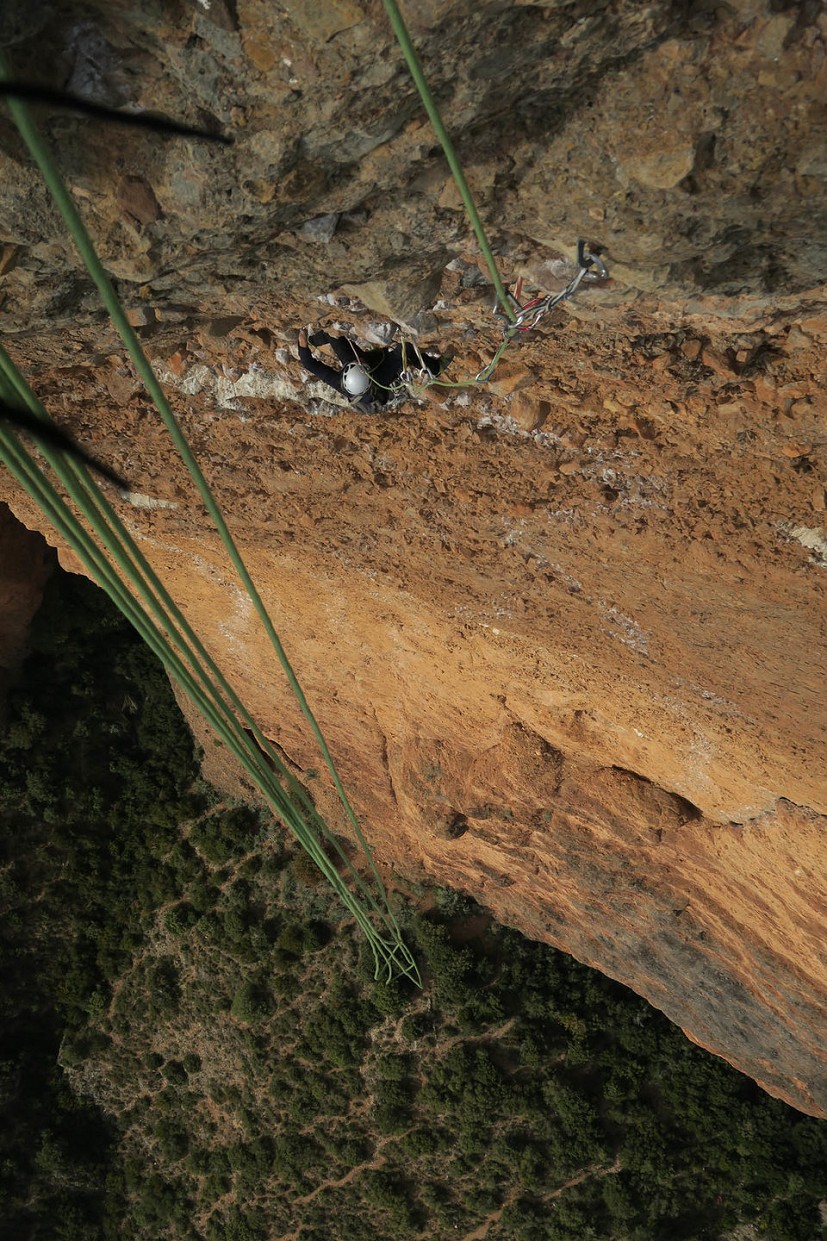
This next section was much like the previous pitches – positive holds, albeit much, much steeper, and with the odd tricky move thrown in to keep you on your toes. But one thing I hadn't expected was the marked change in bolting. The earlier pitches had been very run out – sometimes 4 or 5 metres of climbing between bolts. This was completely different, with the next bolt seeming to appear every couple of moves, presumably in recognition of the steepness, and to help the many people who use aid on this pitch. This was a mixed blessing, providing much needed reassurance, but also requiring stopping and a bit of extra effort at every clip.
Soon I arrived beneath an open niche just beneath the transition from brown conglomerate to the compact grey rock which marks the very lip of the wall. I'd heard that this transition was where most people fail, so presumably the jugs which had propelled me up the crazy wall below, were about to run out? There was a bolt at the base of the niche, and I could see another in the bulge above. I had to move fast as I was terminally pumped, but as I went for a quickdraw, disaster! – the cupboard, at least on the accessible side of my harness, was bare! A contorted reach round the blind side recovered a draw and I got the rope in with some relief.
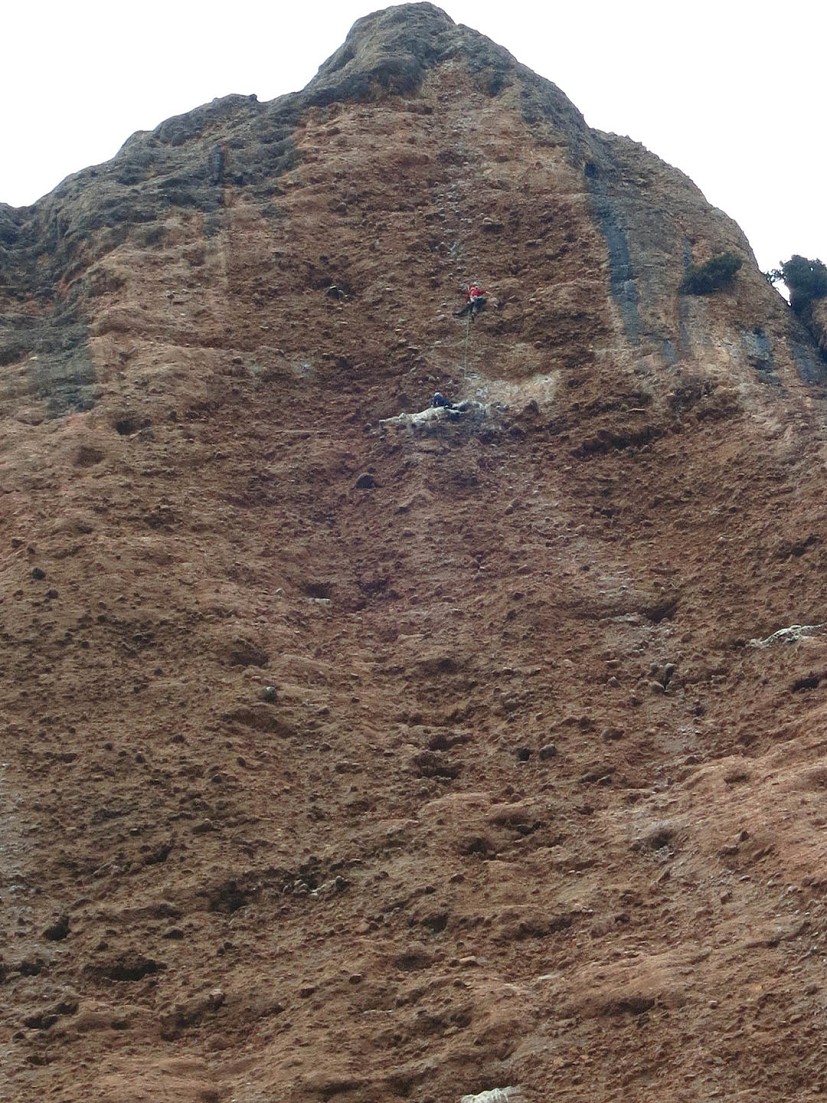
I pulled up right into the niche and momentarily surveyed the situation. I had to clip the last bolt up in the grey bulge above, but when I looked down at my harness to my horror I discovered there were no draws left! Then, a split second later I realised the 2 extended 4ft slings Steve had used on the previous pitch were still round my neck. Like an idiot, I'd forgotten to re-assemble them on the stance below. With fingers opening I stretched up and clipped one of Steve's slings into the bolt. But even getting the rope in was non trivial, as inevitably the bottom krab had turned upside down. Whilst this fumbling clipping the last two bolts only added seconds, it could not have been more critical given the state of my arms. What was needed now was a last super-human effort, and a dose of luck in spotting the correct finishing sequence first time.
I could see a blocky upside-down hold which could form a flat undercut and I powered into that, before making a full stretch up left to a fingerhold. Sometimes my lank helps, but I soon realised I'd overreached, having to quickly run both legs out past the line of the fingerhold to counter the inevitable barn door as I let go of the undercut, and even then I had to catch a small hold with my right to control the swing. Only a few feet to go, but in a cruel twist the holds suddenly become slopers, even though a rampline for the feet beckons you on into the land of the merely vertical. In one last herculean effort, I mustered all my last reserves and scrabbled over the line, eyes bulging, adrenaline surging, a guttural roar shattering the peace.
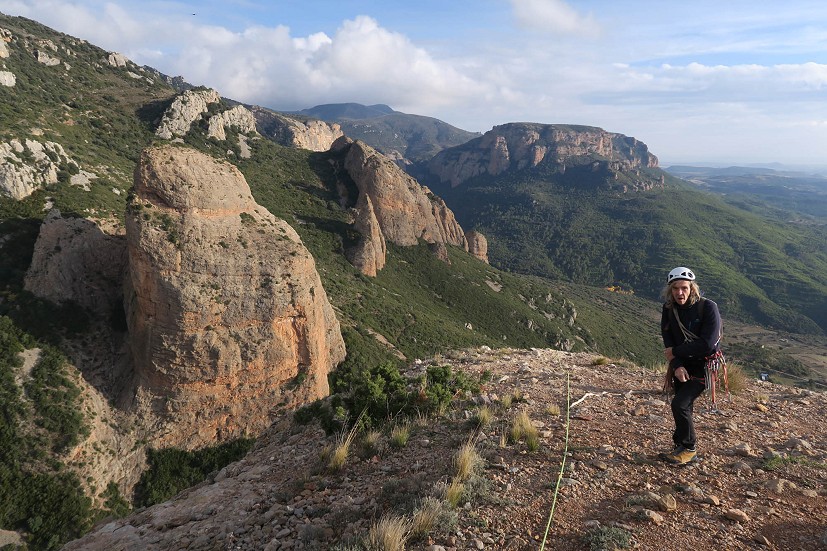
What a pitch! What a route! Steve powered his way up the steepness, and just over 4 hours after leaving the floor, we were standing on the top of La Visera, very pumped, very pumped up, and very, very chuffed!
Who knows? Perhaps there's life in the old dogs yet…..?
- The Long Reach - A day on the Etive Slabs 7 Aug, 2012
- REVIEW: Belay Devices 25 Jul, 2012
- Rockfax Pembroke 5 Oct, 2009

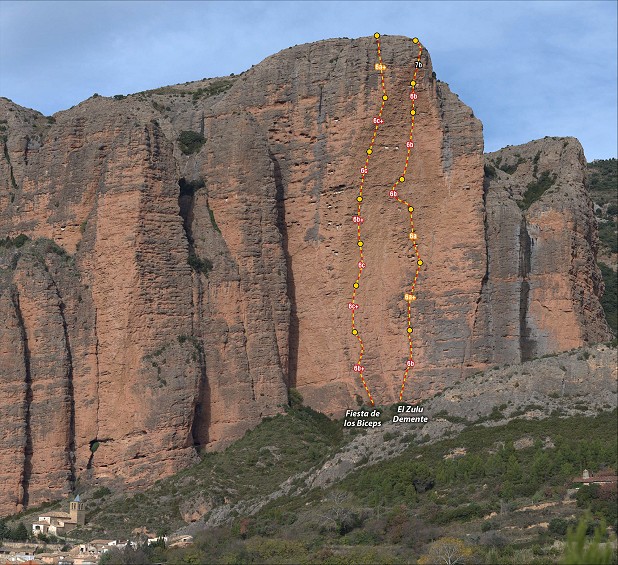
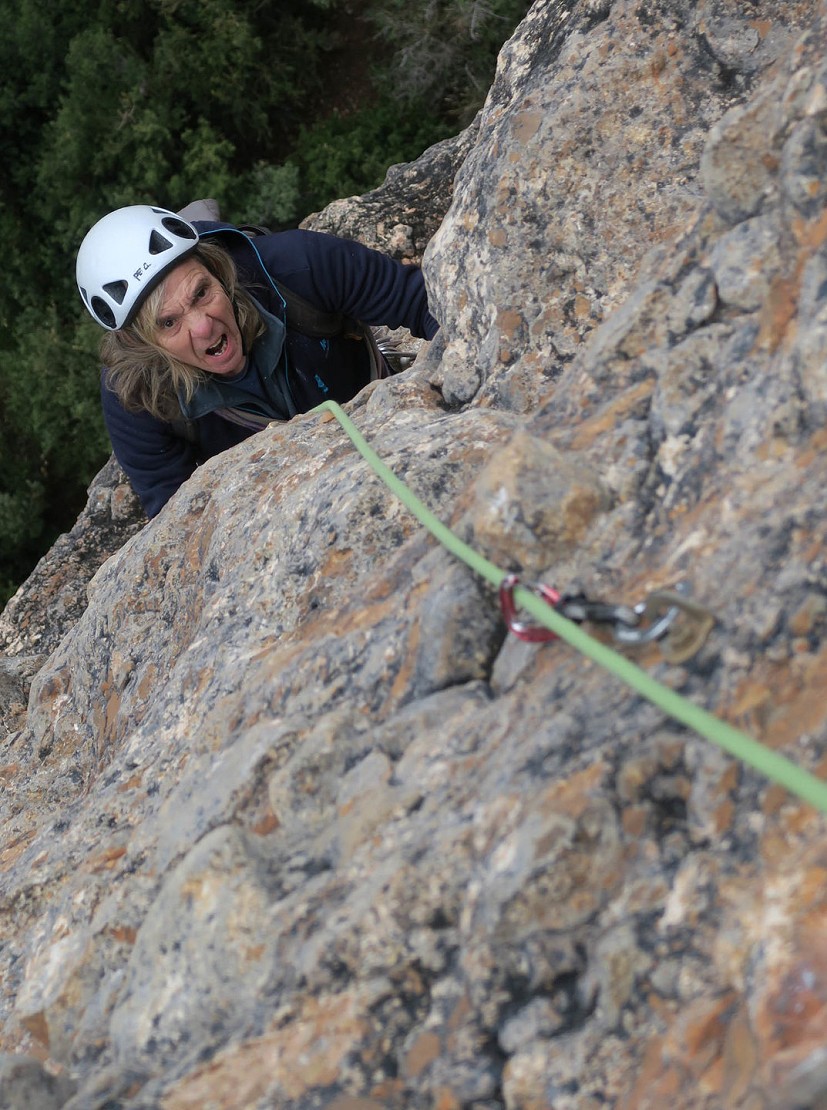
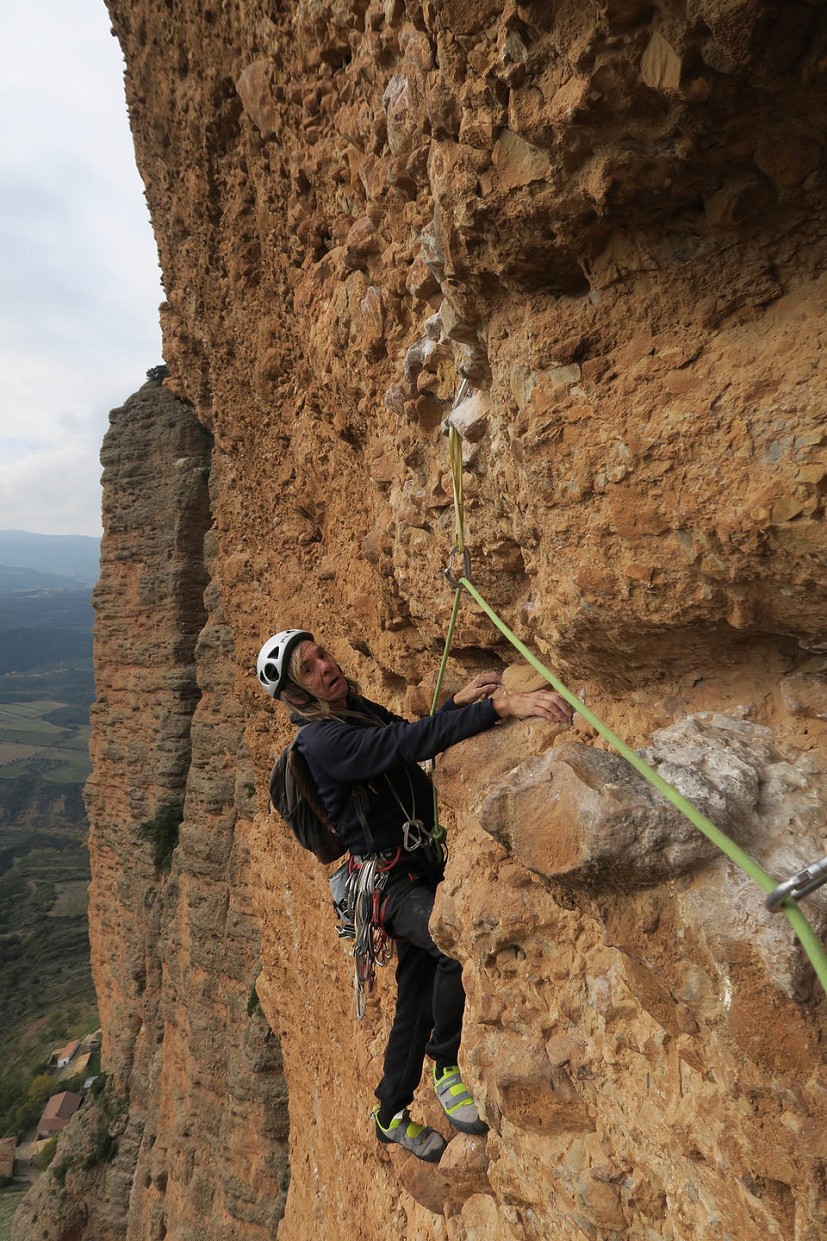
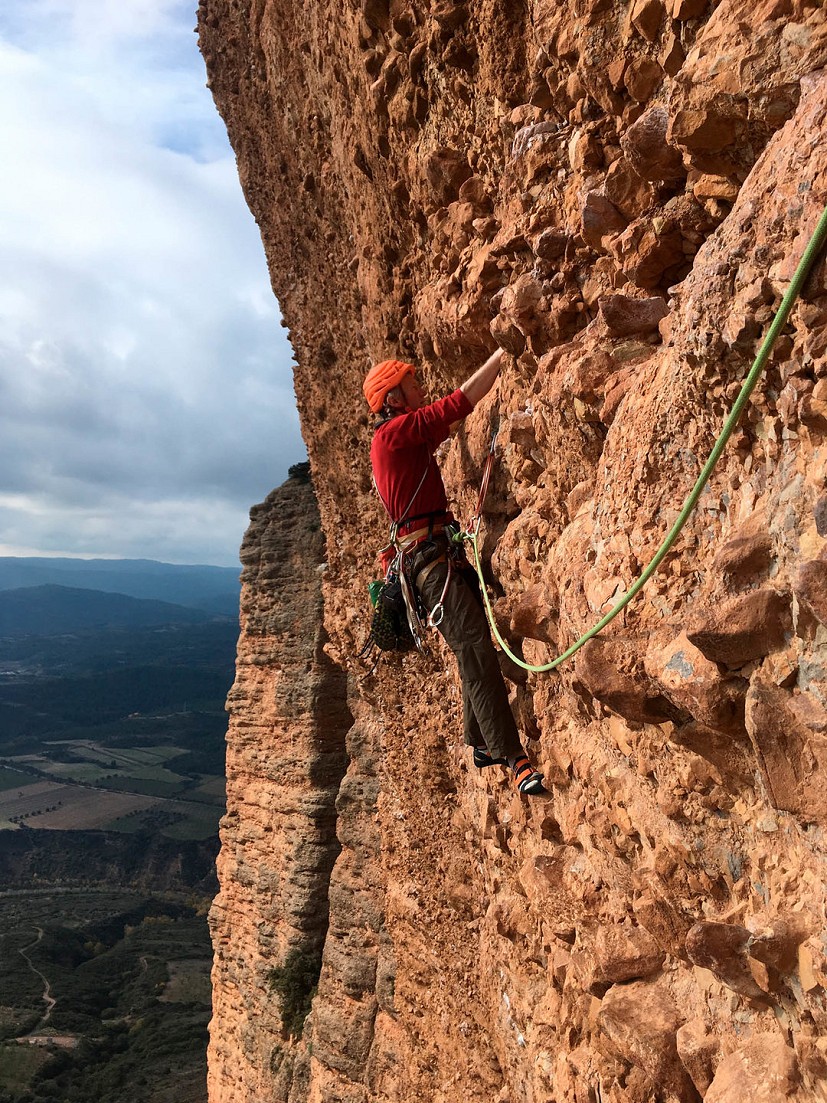
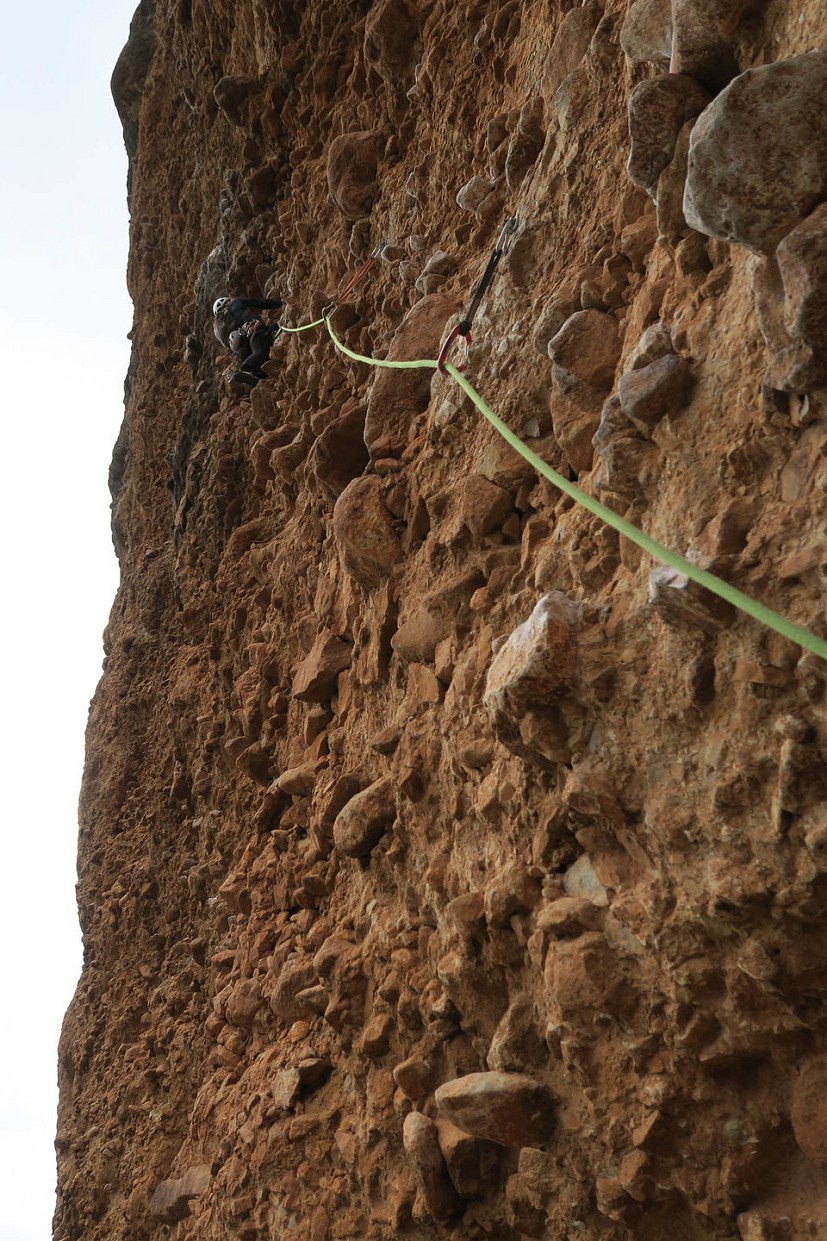
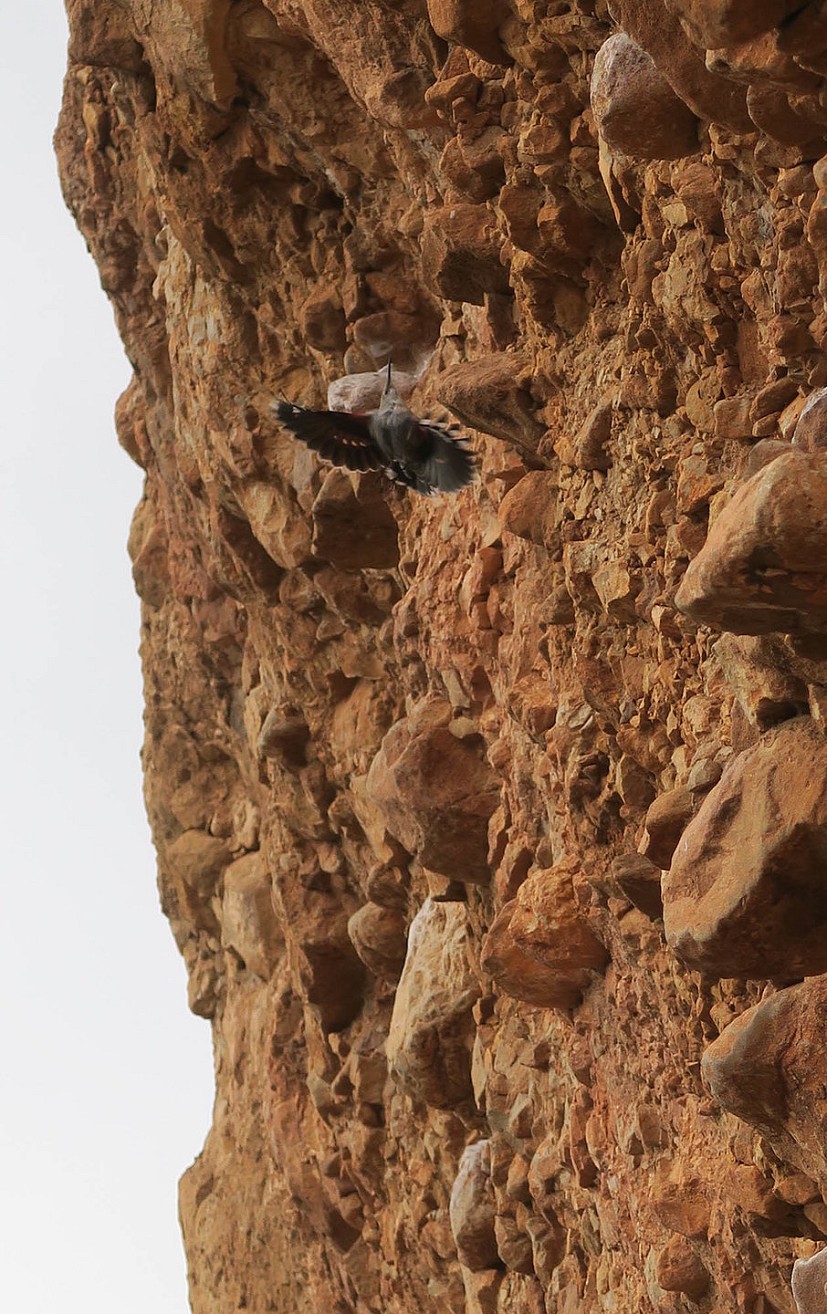
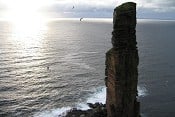

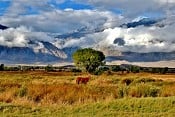

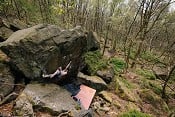








Comments
Enjoyed that - good effort guys :-)
Chris
Nice one Neil and a great title.
Yep, agreed - having worked in a newspaper office where headline-writing is one of the great communal/collaborative tasks, that's a good one. I suppose in an ideal world the piece would have been about Simon Yates, but you can't have everything.
Having seen Neil in his determined mode many times, I can confirm that this article contains zero artistic license :) I felt I was there... Looking forward to the Fiesta one!